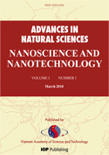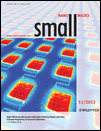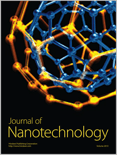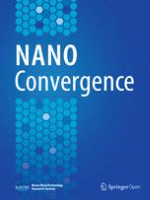
Advances in Natural Sciences-Nanoscience and Nanotechnology
Scope & Guideline
Transforming Ideas into Nanotechnological Breakthroughs
Introduction
Aims and Scopes
- Nanomaterials Synthesis and Characterization:
Research articles often explore novel methods for synthesizing nanomaterials, including green synthesis techniques using biological methods. Characterization of these materials is crucial for understanding their properties and potential applications. - Applications in Medicine and Biotechnology:
A significant portion of the journal's articles discusses the application of nanotechnology in biomedicine, including drug delivery systems, antimicrobial agents, and cancer therapy, highlighting the intersection of nanotechnology with health sciences. - Energy and Environmental Applications:
The journal emphasizes the use of nanomaterials in energy storage, conversion, and environmental remediation. Studies often focus on photocatalysis, sensors, and materials for batteries, showcasing the role of nanotechnology in addressing global challenges. - Nanocomposites and Hybrid Materials:
Papers frequently address the development of nanocomposites that combine different materials to enhance properties such as strength, conductivity, and reactivity, with applications in various fields including electronics, construction, and healthcare. - Theoretical and Computational Studies:
The journal includes research that employs theoretical models and simulations to predict the behavior and properties of nanomaterials, contributing to a deeper understanding of nanotechnology at the molecular level.
Trending and Emerging
- Green and Sustainable Nanotechnology:
There is a growing trend towards the development of environmentally friendly synthesis methods for nanomaterials, emphasizing sustainability and reduced environmental impact in research practices. - Nanotechnology in Drug Delivery and Therapeutics:
Research focusing on the use of nanoparticles for targeted drug delivery systems and therapeutic applications, particularly in cancer treatment, is increasingly prominent, highlighting the potential of nanotechnology in personalized medicine. - Sensors and Detection Technologies:
The emergence of advanced nanomaterials in sensor technology is a significant trend, with applications ranging from environmental monitoring to medical diagnostics, reflecting the demand for sensitive and specific detection methods. - Nanotechnology for Energy Solutions:
Innovative applications of nanotechnology in energy storage and conversion, including advanced battery materials and photocatalysts for clean energy generation, are gaining traction, aligning with global efforts to address energy challenges. - Biocompatibility and Biodegradability of Nanomaterials:
Research on the biocompatibility and biodegradability of nanomaterials is becoming increasingly important, particularly for biomedical applications, as the field seeks to ensure safety and efficacy in human health applications.
Declining or Waning
- Traditional Nanomaterial Synthesis Methods:
There has been a noticeable decrease in articles focusing on conventional synthesis methods, such as chemical vapor deposition or solid-state reactions, as the field moves towards greener and more sustainable synthesis approaches. - Basic Theoretical Studies Without Experimental Validation:
The journal is increasingly favoring studies that combine theoretical work with experimental validation. Consequently, purely theoretical papers that do not offer experimental results or applications are becoming less common. - General Reviews on Nanotechnology:
While comprehensive reviews are valuable, the journal seems to be moving away from broad overviews of nanotechnology towards more focused articles that provide novel insights or specific case studies, leading to a decline in generic review articles. - Applications of Nanotechnology in Non-Scientific Fields:
Research articles exploring the application of nanotechnology in less scientifically rigorous fields, such as certain areas of arts or humanities, are becoming less frequent, reflecting a more focused scope on scientific and technological advancements.
Similar Journals

Small
Innovating Across Disciplines, One Small Step at a Time.Small is a premier academic journal published by WILEY-V C H Verlag GmbH, focusing on cutting-edge research across a multitude of disciplines including biomaterials, biotechnology, chemistry, engineering, materials science, medicine, and nanoscience. With an impressive impact factor and recognized in the top quartile (Q1) across these categories, Small serves as a vital platform for scientists and researchers aiming to disseminate innovative findings and explore the interplay between small-scale materials and their large-scale applications. Enjoying a broad readership, the journal has been key in advancing knowledge from its inception in 2005 and aims to foster collaborations and discussions that steer the future of material science and biotechnology. Though not open access, research published in Small remains invaluable for professionals and students eager to explore the advancements at the nanoscale, promoting a comprehensive understanding of modern scientific challenges and opportunities.

Nanofabrication
Exploring New Dimensions in NanofabricationNanofabrication is a leading open-access journal dedicated to advancing the field of nanotechnology through innovative research and comprehensive reviews. Published by the Eurasia Academy Publishing Group (EAPG) since 2014, this journal aims to provide a platform for academic discourse, promoting the latest insights and findings in nanofabrication techniques and applications across diverse domains, including materials science, electronics, and drug delivery systems. With a commitment to accessibility, Nanofabrication ensures that all content is freely available to researchers, professionals, and students worldwide, thereby fostering collaboration and knowledge sharing in the rapidly evolving landscape of nanotechnology. The journal's emphasis on high-quality, peer-reviewed research positions it as an authoritative source for those looking to stay at the forefront of developments in the field.

Discover Nano
Fostering Innovation through Collaborative ResearchDiscover Nano is a pioneering journal published by SPRINGER, dedicated to the rapidly evolving field of nanoscience and nanotechnology. Established in 2023, this innovative platform provides an open-access forum for researchers, professionals, and students to share and disseminate cutting-edge findings in materials science and condensed matter physics. With its commitment to accessibility, Discover Nano encourages a broad spectrum of contributions, aiming to foster collaboration and stimulate discussion in this dynamic area of study. As a new entry into the academic community, the journal holds great potential for growth, aspiring to increase its visibility and impact in the materials science arena, where it currently ranks in the bottom quartile for both materials science and physics categories. Based in Germany and reaching a global audience, Discover Nano represents a significant opportunity for those looking to shape the future of nanotechnology through impactful research and interdisciplinary dialogue.

Nano Materials Science
Transforming Theoretical Insights into Practical Solutions.Nano Materials Science is a premier open-access journal dedicated to the dissemination of groundbreaking research in the fields of nanotechnology, materials science, and chemical engineering. Published by KEAI PUBLISHING LTD, this journal has quickly established itself as a leading platform in its area since its inception in 2019, with impressive rankings in the Scopus database, holding a Q1 position across multiple categories, including Chemical Engineering and Materials Science. Based in Beijing, China, Nano Materials Science provides researchers and practitioners access to a wealth of high-quality peer-reviewed articles, fostering innovation and collaboration within the scientific community. With its impact factor steadily rising and a commitment to open access, the journal aims to bridge the gap between theoretical research and practical applications, making it an essential resource for professionals and students eager to stay at the forefront of materials research and nanotechnology advancements.

International Journal of Nanoscience
Innovating the Future through Nanoscience ResearchThe International Journal of Nanoscience, published by WORLD SCIENTIFIC PUBL CO PTE LTD, stands as a significant platform in the multidisciplinary field of nanoscience and nanotechnology, offering a unique insight into innovative research developments and applications from 2004 to 2024. Based in Singapore, this journal provides an academic space for researchers, professionals, and students to explore the latest advancements across its wide-ranging scopes, which include bioengineering, biotechnology, computer science applications, condensed matter physics, electrical engineering, and materials science. While currently categorized in Q4 quartiles across multiple fields, the journal's commitment to quality research and scholarly discourse positions it as a pivotal resource for driving forward the understanding and application of nanoscience. Despite its non-open access format, the journal invites subscriptions from institutions and individuals eager to stay ahead in this rapidly evolving discipline. By fostering an environment of collaboration and innovation, the International Journal of Nanoscience aims to contribute significantly to the body of knowledge essential for future breakthroughs in science and technology.

Journal of Nano Research
Transforming Ideas into Nano InnovationsThe Journal of Nano Research, published by Trans Tech Publications Ltd, is a distinguished academic journal dedicated to the rapidly evolving field of nanotechnology and materials science. With an ISSN of 1662-5250 and an E-ISSN of 1661-9897, the journal has been an important platform for researchers and professionals since its inception in 2008, continuing to provide high-quality peer-reviewed research through to 2024. Nestled in Switzerland, the Journal of Nano Research plays a pivotal role in disseminating cutting-edge findings, as recognized by its categorization in Q3 for Materials Science and Physics while being positioned in Q4 for Nanoscience and Nanotechnology as of 2023. With Scopus rankings highlighting its impact, including Rank #129 in general Physics and Astronomy and Rank #300 in Materials Science, this journal is crucial for academics seeking to stay ahead in research trends and innovations in nano-related disciplines. Although it operates under a subscription model, the journal's objectives include fostering collaboration and knowledge-sharing among researchers, making it an invaluable resource for anyone immersed in the world of nanotechnology.

Journal of Nanotechnology
Exploring the Boundaries of Nanotechnology InnovationThe Journal of Nanotechnology, published by Hindawi Ltd., is a premier open-access platform dedicated to delivering high-quality research in the dynamic field of nanotechnology. With the ISSN 1687-9503 and E-ISSN 1687-9511, this journal has been at the forefront of disseminating innovative findings since its transition to open access in 2009, fostering a global dialogue among researchers, professionals, and students. Based in Egypt, the journal maintains its commitment to advancing the material science sector, currently holding a prestigious Q2 ranking in the 2023 Materials Science (miscellaneous) category, reflecting its significant contribution to the field. With a Scopus ranking of #162 out of 463 journals in General Materials Science, placing it in the 65th percentile, the Journal of Nanotechnology serves as a crucial resource for those looking to explore the latest advancements and applications in nanomaterials. The journal invites submissions that align with its scope, which emphasizes interdisciplinary approaches and novel methodologies, promising to enhance both academic and practical aspects of nanotechnology.

Nanoscience and Technology-An International Journal
Innovating Tomorrow's Materials TodayNanoscience and Technology-An International Journal, published by BEGELL HOUSE INC, is a leading platform dedicated to the rapidly evolving fields of nanoscience and nanotechnology. With its ISSN 2572-4258 and E-ISSN 2572-4266, the journal serves as a crucial resource for researchers, professionals, and students alike, focusing on advanced materials, condensed matter physics, and mechanics of materials. It holds a commendable position in the scholarly community, evidenced by its Q2 ranking in 2023 across multiple categories including Condensed Matter Physics and Materials Science. The journal aims to disseminate high-quality research, promote interdisciplinary collaboration, and facilitate innovation within the nano realm. With its convergence period from 2019 to 2024, it continues to attract a diverse array of studies and insightful contributions, reinforcing its importance in shaping the future of nanotechnology and its applications.

Inorganics
Catalyzing Collaboration in Inorganic ResearchInorganics is a vibrant, peer-reviewed Open Access journal dedicated to advancing the field of inorganic chemistry, published by MDPI since 2013. Based in Switzerland, this journal aims to provide a dynamic platform for researchers, professionals, and students to share groundbreaking findings, fostering collaboration and innovation within the global scientific community. With an impressive Q2 ranking in the category of Inorganic Chemistry as of 2023, Inorganics stands out as a significant conduit for high-quality research that spans a wide range of topics from coordination compounds to metal-organic frameworks. Its commitment to accessibility ensures that cutting-edge research can be accessed, utilized, and built upon by a diverse audience, thereby amplifying its impact. Join the conversation in Inorganics and contribute to the ever-evolving landscape of inorganic chemical research.

Nano Convergence
Fostering innovation through the convergence of disciplines.Nano Convergence is a premier open access journal dedicated to the rapidly evolving fields of nanotechnology, materials science, and engineering. Published by SPRINGER, this journal has been at the forefront of interdisciplinary research since its inception in 2014, and is set to continue its journey until 2024. With an impressive impact factor and recognition as Q1 in both Engineering (miscellaneous) and Materials Science (miscellaneous) categories, Nano Convergence ranks among the top publications, listed as Rank #8 out of 307 in General Engineering and Rank #34 out of 463 in General Materials Science according to Scopus metrics. This journal provides a platform for researchers, professionals, and students to share pioneering studies that converge different disciplines within nanotechnology. With its commitment to open access, Nano Convergence ensures that cutting-edge research is readily available to the global community, fostering innovation and collaborative advancements in the field.